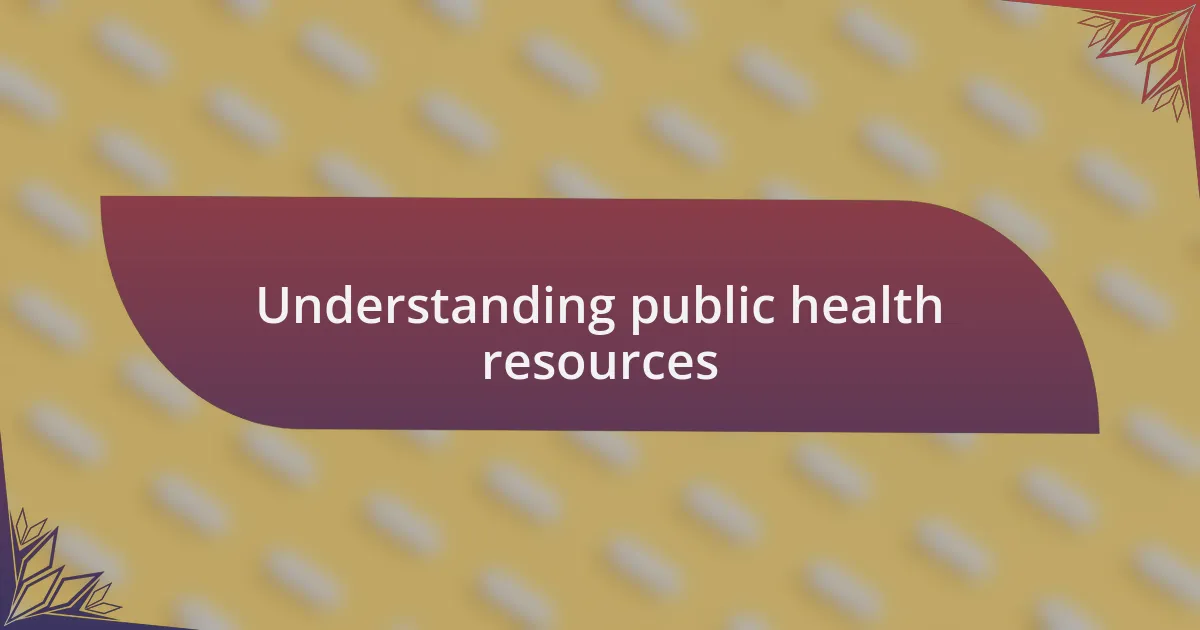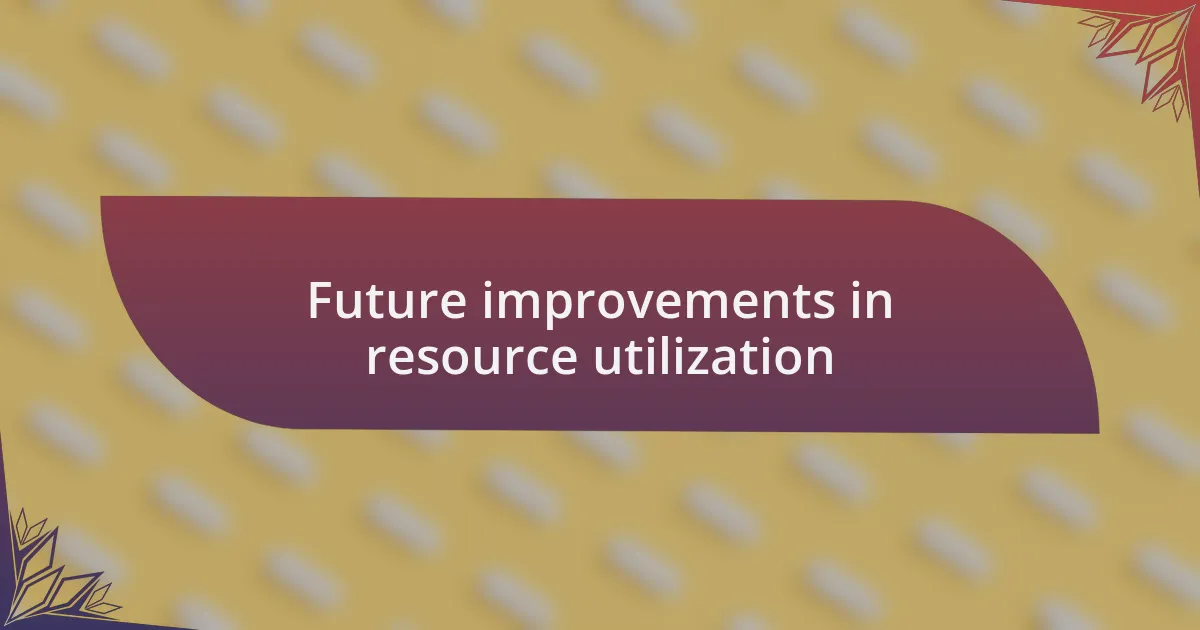Key takeaways:
- Understanding public health resources enhances community awareness and informs better health decisions.
- Educational resources should be clear, relevant, and credible to effectively engage audiences and improve understanding.
- Utilizing diverse formats and fostering collaboration can significantly enhance the effectiveness of educational resource usage.
- Future improvements should focus on data analytics, centralized platforms, and technological innovations for more impactful resource engagement.

Understanding public health resources
Understanding public health resources is crucial for improving community well-being. I remember the first time I stumbled upon a public health resource during my college days. I was struggling to grasp the statistics on disease prevention, but that resource provided clarity and context that transformed my perspective. Have you ever felt lost amidst the data?
Diving deep into public health resources reveals layers of valuable information, from statistical data to guidelines on healthy living. I recall a friend who utilized these resources when their community faced a sudden rise in flu cases. By accessing reliable information, they were able to educate others on prevention measures effectively. It’s powerful how the right resources can create ripples of awareness in a community.
Moreover, understanding public health resources isn’t just about academic knowledge; it’s about real-life application and impact. I once used a public health database to identify local health trends for a project. The insights I gained not only shaped my conclusions but also ignited a passion to advocate for better health policies. Wouldn’t you agree that such knowledge can empower every individual to make informed decisions?

Importance of educational resources
Educational resources are vital because they bridge the gap between complex health information and everyday understanding. I remember a workshop I attended where we discussed how to decode health statistics. The resource materials transformed dry numbers into relatable stories, highlighting the human impact behind the data. Have you ever thought about how a single piece of information can shift a whole community’s behavior?
Additionally, accessible educational resources empower individuals to take charge of their health. I once came across a simple infographic on nutrition that not only educated me but also inspired my whole family to eat more fruits and vegetables. It was astonishing to see how something as straightforward as a visual guide could lead to healthier choices at home. Don’t you think we often underestimate the influence of well-designed educational tools?
Furthermore, the importance of educational resources lies in their ability to foster critical thinking and informed discussions. During my time volunteering at a local health clinic, I noticed patients who had accessed public health materials were more engaged in conversations about their care. Their improved understanding allowed for more productive dialogues between healthcare professionals and patients. Isn’t it refreshing to see how knowledge can transform conversations around health?

Criteria for choosing educational resources
When selecting educational resources, clarity is paramount. I’ve often found that materials that use straightforward language resonate more effectively with audiences. For instance, I once evaluated a public health brochure that seemed overly technical, which ultimately left many confused. Have you ever struggled to grasp an important concept simply because the language was too complicated?
Another critical aspect is relevance. I recall a time when I was sifting through online resources for a community health initiative. The most impactful materials were those directly aligned with the community’s specific health needs. If resources don’t connect with the audience’s context, they can easily be overlooked. Isn’t it fascinating how tailored information can spark immediate interest and action?
Lastly, credibility plays a vital role in choosing educational resources. When I came across a video made by a respected health organization, I was much more inclined to trust its content. This experience taught me that aligning educational materials with recognized authorities adds a layer of reassurance. Don’t you think that knowing something comes from a reliable source can greatly affect how we perceive and utilize that information?

Effective strategies for using resources
Effective strategies for harnessing educational resources hinge on active engagement. I remember attending a public health seminar where they encouraged us to participate in hands-on activities. This approach not only made the information more accessible but also personal, transforming passive listeners into active learners. Have you ever noticed how much more you retain when you’re involved rather than just sitting back?
Another strategy I’ve found valuable is leveraging multiple formats. While I initially preferred reading articles, I discovered that integrating videos and podcasts enriched my understanding. For example, a short documentary I viewed about community health practices provided visuals that really illustrated the data I had read. Isn’t it interesting how seeing something in action can deepen comprehension in ways text alone might not achieve?
Lastly, collaboration with colleagues can greatly enhance your resource utilization. I recall a productive brainstorming session with fellow health educators where we pooled our favorite resources. Sharing insights not only broadened our perspectives but also led to discovering overlooked materials that became game-changers in our curriculum. Isn’t it true that collaboration often unveils new angles and enriches our approach?

Future improvements in resource utilization
Future improvements in resource utilization can be significantly driven by integrating data analytics into our strategies. I’ve witnessed firsthand how data can inform decision-making processes, particularly when I participated in program evaluations. By analyzing usage patterns, we can identify what really resonates with users and adjust our offerings accordingly. Have you ever wondered how much more effective our resources could be if they were tailored to actual user needs?
Another exciting prospect for resource utilization lies in creating a centralized platform for sharing best practices. I vividly remember struggling to keep track of various resources scattered across different websites. A well-organized hub can streamline access and promote collaboration among educators in diverse fields. When resources are easier to find and share, doesn’t it seem like we’re all better positioned to enhance our educational impact?
Additionally, embracing technological innovations can revolutionize how we engage with educational content. I recently started using mobile applications designed for health education, which allowed me to learn on-the-go during my commute. Imagine if we could harness virtual reality or augmented reality to simulate real-world public health scenarios! Wouldn’t that elevate the learning experience and make complex ideas more tangible?